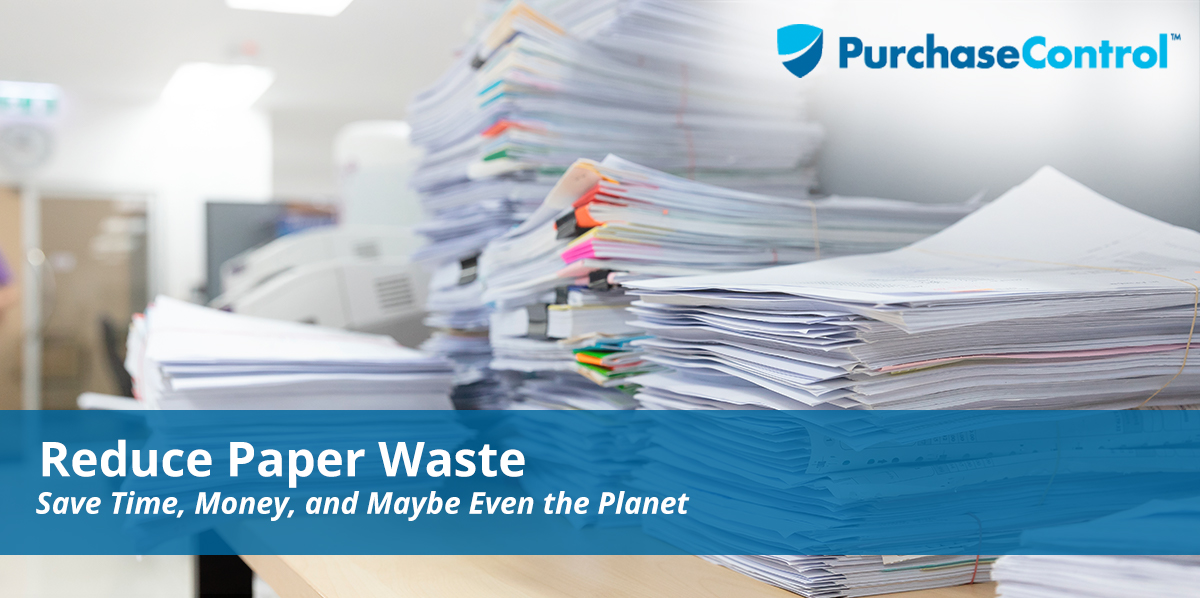One of the more promising aspects digital disruption brings to the modern workplace is the possibility of a truly paperless office. Paper is costly—both in time and resources—to produce, and paper waste is a serious concern across the globe. Trading old-school pen and paper for digital document management holds the potential to slash not just expenses, but the corporate environmental footprint.
The fight to reduce paper waste begins at the micro level. With updated practices and new technology, every individual has it within their power to contribute to eco-friendly, positive changes that reduce paper consumption while boosting productivity and profits.
Why Reduce Paper Waste?
Humans love paper. As of 2016, we were producing and consuming around 413 million tons of the stuff worldwide each year. The average office employee in the United States uses around 10,000 sheets of copy paper in a single year—and the average American’s annual paper use is roughly equal to a ten-story Douglas Fir tree.
In a world where nearly 90% of all office documents are still printed on paper, and up to 80% of office processes rely on pen and paper, it’s hard to believe Newsweek was predicting the end of paper in “The Office of the Future” way back in 1975. Paper use continues to be a significant source of profit, but it’s also a massive strain on corporate and natural resources.
The widespread embrace of email and the Internet for communication, research, and entertainment has helped, but it’s become increasingly clear that reducing, let alone eliminating, paper use can still generate radical increases in cost savings and even more significant reductions in environmental impact.
“Set your sights on the areas most in need of improvement and establish the cost reductions (either in dollars or as a percentage) you’d like to achieve through transitioning those areas to paperless processes. Incremental changes as part of process improvement can create the desired impact in stages, allowing you to set and achieve targets to save money without impacting productivity.”
Building a Paperless Paradise
Bringing to life the truly paperless future we’ve been dreaming of since the ’70s requires a shift in mindset, practice, and technology.
Lean Into the Three Rs
Public education initiatives urging the public to Reduce, Reuse, and Recycle resonate especially loudly in the modern workplace, where almost half of paper used still ends up in the trash can rather than recycling bins.
- Build a paper-slashing budget. Stepping down from your current levels of paper use to a fully paperless environment will take time, money, and care. Set your sights on the areas most in need of improvement and establish the cost reductions (either in dollars or as a percentage) you’d like to achieve through transitioning those areas to paperless processes. Incremental changes as part of process improvement can create the desired impact in stages, allowing you to set and achieve targets to save money without impacting productivity.
- Use both sides of each sheet of paper. In one fell swoop, you’re reducing your paper usage by 50% when you print on both sides of the paper. Many modern printers and multi-function devices have double-sided printing, so take advantage. For drafts and unofficial material, discarded single-sheets can be reloaded and printed on their empty side for even more savings.
- Plan before you print. Do you really need to print that email, office poll, or 40-page presentation? Taking a moment to ask yourself whether you can accomplish your goals digitally will cut your paper consumption significantly.
- Manage your printers more efficiently. Move away from the “printer on every desk” model and toward a centralized, passcode-controlled printer for each department. Route printer use data to your centralized document management suite to provide insight on where paper is being used, how much paper is being wasted, and how it can be reduced or eliminated.
- Don’t use paper—REUSE it. Collect and recycle all waste paper, including often overlooked sources like junk mail. Throw out the paper towels and switch to cloth napkins in the breakroom. When you need to purchase new paper products, buy only recycled paper that’s been processed in an eco-friendly way. Save coated or heavy office papers for special documents, and get the recycled versions whenever possible.
- Get your whole team on board. Like any other cultural change, the move to paperless requires an adjustment and new training for management, staff, and suppliers. Consider creating incentives to encourage everyone to save paper. Create online versions of commonly accessed employee resources like handbooks, memos, and policies to replace paper documents.
Tame Paper Waste with Technology
The transition to a paperless office landscape is much easier with help from technology.
- Look beyond email. While electronic mail has certainly reduced the amount of paper, many offices still use the post for the bulk of their correspondence. Even the fax machine—something of a relic outside the office environs—still gets a workout in many otherwise updated workflows. Distribute paychecks and other financial documents electronically. Wherever you have the opportunity, communicate, share, store, and manage your documents digitally.
- Centralize, digitize, and optimize. It should probably go without saying, but not every document needs a hard copy. That piece of paper not only consumes resources, but has to be stored, managed, and backed up digitally, generating additional costs that vanish when your document management is virtualized. Digital software signatures allow for high security while still permitting files to be accessed and shared by authorized users.
Document management (including procurement and financials) as part of a centralized software solution eliminates redundancies and errors while creating comprehensive connections between all your disparate data sources and far-flung users. Artificial intelligence (AI) and automation can ensure all your documents and transaction-related information are created, routed, stored, and shared accurately and safely, without the need for paper. Electronic documents speed up billing, payroll, financial analysis, and strategic planning, too.
In addition, software solutions can pair with their corresponding apps to make everyday document-related tasks not just digital, but fully mobile. Having access to essential information, and being able to share, modify, and analyze it on the go, will have your whole team using less paper no matter where they are. - Go digital in practice as well as policy. A little imagination can save a lot of money. Establish all meetings as paperless, encouraging employees to bring their laptops or mobile devices to collaborate via your app, email, and tools like Google Docs. Make sure minutes and presentations are distributed electronically after every meeting. Create “achievements” (with small rewards) for app users to incentivize paperless practices.
Go Paperless for More Profit and Productivity
The millennia-long love affair with the humble piece of paper is unlikely to peter out overnight. And we’ll most likely always use and need paper for a variety of tasks. But for businesses looking to save serious money and drive process improvement and productivity, the writing’s on the wall: digital document management is the foundation of the paperless, eco-friendly office of tomorrow.
Make the Leap to Digital Procurement and Reduce Your Carbon Footprint
Find Out How








